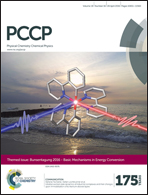Fourth stable radical species in X-irradiated solid-state sucrose†
Abstract
High-energy radiation produces radicals in crystalline sucrose. As such, sucrose is considered as a relevant model system for studying radiation damage to the sugar units of DNA. Many of these radicals are stable, detectable at room temperature with electron paramagnetic resonance (EPR) and their concentration is proportional to the absorbed dose in a considerable range. This makes sucrose also an interesting system for dosimetry. Dose assessment protocols rely on measurements of the total intensity of the EPR powder spectrum, so it is likely that they could be further improved if the composite nature of the spectrum was understood completely. Recently, it was shown that the three known stable radicals can only account for the central part of the spectrum and that features in the wings remain unidentified. In this work, we show, based on the analysis of the powder EPR patterns recorded at three microwave frequencies, that the contribution of one more species is sufficient to explain the entire spectrum. The determination of the spin Hamiltonian parameters is corroborated by a Q-band (34 GHz) single crystal electron-nuclear double resonance (ENDOR) analysis. The chemical structure of the fourth species is explored by analysis of the determined g and four 1H hyperfine (HF) tensors, and verified using density functional theory (DFT) calculations. The ENDOR spectrum of the largest HF interaction of the fourth species was exploited to isolate the radical's absorption-like EPR spectrum from a multicomponent powder pattern.



 Please wait while we load your content...
Please wait while we load your content...